Researchers from the Georgia Institute of Technology in the US have developed several robots inspired by our leggy insect friend, the centipede.
Centipedes are known for their wiggly walk. With tens to hundreds of legs, they can traverse any terrain without stopping.
The team of engineers developed a new theory of multilegged locomotion and created many-legged robotic models, discovering the robot with redundant legs could move across uneven surfaces without any additional sensing or control technology as the theory predicted. These robots can move over complex, bumpy terrain – and there is potential to use them for agriculture, space exploration, and even search and rescue.
“When you see a scurrying centipede, you’re basically seeing an animal that inhabits a world that is very different than our world of movement,” said Daniel Goldman, the Dunn Family Professor in the School of Physics. “Our movement is largely dominated by inertia. If I swing my leg, I land on my foot, and I move forward. But in the world of centipedes, if they stop wiggling their body parts and limbs, they basically stop moving instantly.”
Baxi Chong, a physics postdoctoral researcher, “We started this project to see what would happen if we had more legs on the robot: four, six, eight legs, and even 16 legs.”
The team developed a theory that proposes that adding leg pairs to the robot increases its ability to move robustly over challenging surfaces – a concept they call spatial redundancy. This redundancy makes the robot’s legs successful on their own without the need for sensors to interpret the environment.
If one leg falters, the abundance of legs falters; the abundance of legs keeps it moving regardless. In effect, the robot becomes a reliable system to transport itself and even a load from A to B on difficult or “noisy” landscapes. The concept is comparable to how punctuality can be guaranteed on wheeled transport if the track or rail is smooth enough but without having to engineer the environment to create this punctuality.
“With an advanced bipedal robot, many sensors are typically required to control it in real-time,” Chong said. “But in applications such as search and rescue, exploring Mars, or even micro-robots, there is a need to drive a robot with limited sensing. There are many reasons for such sensor-free initiatives. The sensors can be expensive and fragile, or the environments can change so fast that it doesn’t allow enough sensor-controller response time.”
Researchers conducted a series of experiments to test this robot, where they built terrains to mimic an inconsistent natural environment. They then tested the robot by increasing its number of legs by two each time, starting with six and eventually expanding to 16. As the theory predicted, the robot could move more agilely across the terrain as the leg count increased, even without sensors. Eventually, they tested the robot outdoors on real terrain, where it was able to traverse a variety of environments.
“It’s truly impressive to witness the multilegged robot’s proficiency in navigating both lab-based terrains and outdoor environments,” said Juntao He, a Ph.D. student in robotics. “While bipedal and quadrupedal robots heavily rely on sensors to traverse complex terrain, our multilegged robot utilizes leg redundancy and can accomplish similar tasks with open-loop control.”
Researchers now want to refine the robot and determine the optimal number of legs to achieve motion without sensing in a way that is cost-effective yet still retains the benefits.
Journal reference:
- Baxi Chong, Juntao He, Shengkai Li, Eva Erickson, Kelimar Diaz, Tianyu Wang, Daniel Soto, and Daniel I. Goldman. Self-propulsion via slipping: Frictional swimming in multilegged locomotors. PNAS, 2023; DOI: 10.1073/pnas.2213698120
